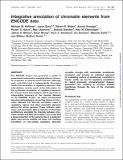| dc.contributor.author | Ernst, Jason | |
| dc.contributor.author | Kellis, Manolis | |
| dc.contributor.author | Hoffman, Michael M. | |
| dc.contributor.author | Wilder, Steven P. | |
| dc.contributor.author | Kundaje, Anshul | |
| dc.contributor.author | Harris, Robert S. | |
| dc.contributor.author | Libbrecht, Max | |
| dc.contributor.author | Giardine, Belinda | |
| dc.contributor.author | Ellenbogen, Paul M. | |
| dc.contributor.author | Bilmes, Jeffrey A. | |
| dc.contributor.author | Birney, Ewan | |
| dc.contributor.author | Hardison, Ross C. | |
| dc.contributor.author | Dunham, Ian | |
| dc.contributor.author | Noble, William Stafford | |
| dc.date.accessioned | 2013-04-02T20:50:53Z | |
| dc.date.available | 2013-04-02T20:50:53Z | |
| dc.date.issued | 2012-12 | |
| dc.date.submitted | 2012-11 | |
| dc.identifier.issn | 0305-1048 | |
| dc.identifier.issn | 1362-4962 | |
| dc.identifier.uri | http://hdl.handle.net/1721.1/78261 | |
| dc.description.abstract | The ENCODE Project has generated a wealth of experimental information mapping diverse chromatin properties in several human cell lines. Although each such data track is independently informative toward the annotation of regulatory elements, their interrelations contain much richer information for the systematic annotation of regulatory elements. To uncover these interrelations and to generate an interpretable summary of the massive datasets of the ENCODE Project, we apply unsupervised learning methodologies, converting dozens of chromatin datasets into discrete annotation maps of regulatory regions and other chromatin elements across the human genome. These methods rediscover and summarize diverse aspects of chromatin architecture, elucidate the interplay between chromatin activity and RNA transcription, and reveal that a large proportion of the genome lies in a quiescent state, even across multiple cell types. The resulting annotation of non-coding regulatory elements correlate strongly with mammalian evolutionary constraint, and provide an unbiased approach for evaluating metrics of evolutionary constraint in human. Lastly, we use the regulatory annotations to revisit previously uncharacterized disease-associated loci, resulting in focused, testable hypotheses through the lens of the chromatin landscape. | en_US |
| dc.description.sponsorship | National Institutes of Health (U.S.) (HG005334) | en_US |
| dc.description.sponsorship | National Institutes of Health (U.S.) (HG004570) | en_US |
| dc.description.sponsorship | National Science Foundation (U.S.) (0905968) | en_US |
| dc.language.iso | en_US | |
| dc.publisher | Oxford University Press | en_US |
| dc.relation.isversionof | http://dx.doi.org/10.1093/nar/gks1284 | en_US |
| dc.rights | Creative Commons Attribution 3.0 | en_US |
| dc.rights.uri | http://creativecommons.org/licenses/by-nc/3.0 | en_US |
| dc.source | Oxford University Press | en_US |
| dc.title | Integrative annotation of chromatin elements from ENCODE data | en_US |
| dc.type | Article | en_US |
| dc.identifier.citation | Hoffman, M. M. et al. “Integrative Annotation of Chromatin Elements from ENCODE Data.” Nucleic Acids Research 41.2 (2012): 827–841. | en_US |
| dc.contributor.department | Massachusetts Institute of Technology. Computer Science and Artificial Intelligence Laboratory | en_US |
| dc.contributor.department | Massachusetts Institute of Technology. Department of Electrical Engineering and Computer Science | en_US |
| dc.contributor.mitauthor | Ernst, Jason | |
| dc.contributor.mitauthor | Kellis, Manolis | |
| dc.relation.journal | Nucleic Acids Research | en_US |
| dc.eprint.version | Final published version | en_US |
| dc.type.uri | http://purl.org/eprint/type/JournalArticle | en_US |
| eprint.status | http://purl.org/eprint/status/PeerReviewed | en_US |
| dspace.orderedauthors | Hoffman, M. M.; Ernst, J.; Wilder, S. P.; Kundaje, A.; Harris, R. S.; Libbrecht, M.; Giardine, B.; Ellenbogen, P. M.; Bilmes, J. A.; Birney, E.; Hardison, R. C.; Dunham, I.; Kellis, M.; Noble, W. S. | en |
| mit.license | PUBLISHER_CC | en_US |
| mit.metadata.status | Complete | |
